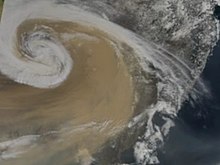Asian brown cloud


The Indian Ocean brown cloud or Asian brown cloud is a layer of
The term atmospheric brown cloud is used for a more generic context not specific to the Asian region.[4]
Causes
The Asian brown cloud is created by a range of
Observations
This pollution layer was observed during the Indian Ocean Experiment (INDOEX) intensive field observation in 1999 and described in the UNEP impact assessment study published 2002.[3] Scientists in India claimed that the Asian Brown cloud is not something specific to Asia.[8] Subsequently, when the United Nations Environment Programme (UNEP) organized a follow-up international project, the subject of study was renamed the Atmospheric Brown Cloud with focus on Asia.
The cloud was also reported by NASA in 2004[9] and 2007.[10]
Although aerosol particles are generally associated with a global cooling effect, recent studies have shown that they can actually have a warming effect in certain regions such as the Himalayas.[11]
Impacts
Health problems
One major impact is on health. A 2002 study indicated nearly two million people die each year, in Asia alone, from conditions related to the brown cloud.[12]
Regional weather
A second assessment study was published in 2008.[13] It highlighted regional concerns regarding:
- Changes of rainfall patterns with the Asian monsoon, as well as a delaying of the start of the Asian monsoon, by several weeks.[14][15] The observed weakening Indian monsoon and in China northern drought and southern flooding is influenced by the clouds.
- Increase in rainfall over the Australian Top End and Kimberley regions. A CSIRO study has found that by displacing the thermal equator southwards via cooling of the air over East Asia, the monsoon which brings most of the rain to these regions has been intensified and displaced southward.[16]
- Retreat of the deposition of black carbon decreases the reflectionand exacerbates the retreat. Asian glacial melting could lead to water shortages and floods for the hundreds of millions of people who live downstream.
- Decrease of crop harvests. Elevated concentrations of surface ozone are likely to affect crop yields negatively. The impact is crop specific.
Cyclone intensity in Arabian Sea
A 2011 study found that pollution is making Arabian Sea cyclones more intense as the atmospheric brown clouds has been producing weakening wind patterns which prevent wind shear patterns that historically have prohibited cyclones in the Arabian Sea from becoming major storms. This phenomenon was found responsible for the formation of stronger storms in 2007 and 2010 that were the first recorded storms to enter the Gulf of Oman.[17][18]
Global warming and dimming
The 2008 report also addressed the global concern of
Another major impact is on the polar ice caps.
See also
- Asian Dust
- Arctic haze
- Air pollution in India
- Chemical Equator
- 1997, 2006, 2009, 2013 Southeast Asian haze
References
- ^ Srinivasan (10 September 2002). "Asian Brown Cloud – fact and fantasy" (PDF). Current Science. 83 (5): 586–592. Archived from the original (PDF) on 5 November 2004.
- .
- ^ ISBN 92-807-2240-9, accessed 8 December 2008
- .
- S2CID 44712883.
- PMC 1241333. Archived from the originalon 2006-08-28.
- ^ Petit, C. W. (2003) "A darkening sky: A smoky shroud over Asia blocks both sun and rain" U.S. News & World Report (17 March 2003), 134(8): pp. 46-8
- PMID 20040987.
- ^ "NASA Eyes Effects of a Giant 'Brown Cloud' Worldwide (2004)". Archived from the original on 2019-02-07. Retrieved 2007-08-21.
- ^ Global Aerosol System 2000-2007 (NASA Earth Observatory)
- S2CID 4420513.
- S2CID 35909421.
- ^ "Archived copy" (PDF). Archived from the original on 2008-11-18. Retrieved 2008-11-18.
{{cite web}}: CS1 maint: archived copy as title (link) CS1 maint: bot: original URL status unknown (link) - ^ Brown cloud delaying monsoon.
- ^ Paper reporting the delaying of the monsoon being caused by brown cloud[permanent dead link]
- hdl:2027.42/94749. Archived from the originalon 2007-09-30.
- ^ "Link Between Air Pollution and Cyclone Intensity in Arabian Sea". National Science Foundation. 2011-11-02. Retrieved 2011-11-07.
- S2CID 4423931.
- ^ Biello, David (August 1, 2007). "Brown Haze from Cooking Fires Cooking EarthToo.The brown haze over Asia warms the atmosphere just as much as greenhouse gases". Scientific American.
- ^ Biello, David (June 8, 2007). "Impure as the Driven Snow: Smut is a bigger problem than greenhouse gases in polar meltdown". Scientific American.
- ^ Boswell, Randy (October 19, 2009). "Burning crops darken Arctic sky, speed polar melt". Canwest News Service. Archived from the original on February 6, 2010.
Further reading
- Ramanathan, V.; Crutzen, P. J. (2003). "New Directions: Atmospheric Brown "Clouds"". Atmospheric Environment. 37 (28): 4033–4035. .
- Silva-Send, Nilmini (2007) Preventing regional air pollution in Asia : the potential role of the European Convention on Long Range Transboundary Air Pollution in Asian regions OCLC 262737812
External links
- Bray, Marianne (2002) "'Asian Brown Cloud' poses global threat" CNN, from WebArchive
